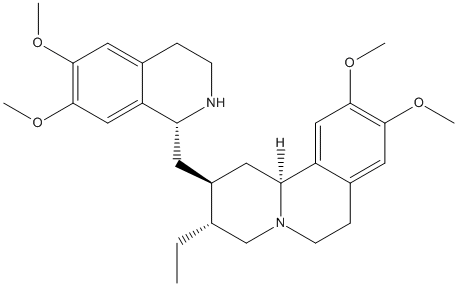Emetine
Emetine Hydrochloride is the chloride salt of a white crystalline bitter alkaloid isolated from the root of the plant Psychotria Ipecacuanha (ipecac root)Uragoga (or Cephaelis) ipecacuanha or U. acuminata, of the Rubiaceae with antiemetic and anthelminthic properties. Emetine inhibits protein synthesis in eukaryotic (but not prokaryotic) cells. It inhibits SARS-CoV2, Zika and Ebola virus replication. Agents that cause vomiting isolated ein 1817 par Pelletier and Magendie. The structure elucidated in 1948. Emetine hydrochloride CAS-14198-59-5 (CID 6603320) ML081 represents the first non-covalent, selective RBBP9 inhibitor but moderate IC50 8 microM
General
Type : Natural,Alkaloid,Drug,Isoquinoline,Quinoline
Chemical_Nomenclature : (2S,3R,11bS)-2-[[(1R)-6,7-dimethoxy-1,2,3,4-tetrahydroisoquinolin-1-yl]methyl]-3-ethyl-9,10-dimethoxy-2,3,4,6,7,11b-hexahydro-1H-benzo[a]quinolizine
Canonical SMILES : CCC1CN2CCC3=CC(=C(C=C3C2CC1CC4C5=CC(=C(C=C5CCN4)OC)OC)OC)OC
InChI : InChI=1S\/C29H40N2O4\/c1-6-18-17-31-10-8-20-14-27(33-3)29(35-5)16-23(20)25(31)12-21(18)11-24-22-15-28(34-4)26(32-2)13-19(22)7-9-30-24\/h13-16,18,21,24-25,30H,6-12,17H2,1-5H3\/t18-,21-,24+,25-\/m0\/s1
InChIKey : AUVVAXYIELKVAI-CKBKHPSWSA-N
Other name(s) : Emetin,Cephaeline methyl ether,ML081,Emetine hydrochloride,Methyl cephaeline,SCHEMBL56277,ZINC3830747,DB13393,CHEMBL50588,CHEBI:4781
MW : 480.6
Formula : C29H40N2O4
CAS_number : 483-18-1 || 14198-59-5
UniChem : AUVVAXYIELKVAI-CKBKHPSWSA-N
IUPHAR :
Wikipedia :

Target
Families : Emetine ligand of proteins in family: Hydrolase_RBBP9_YdeN
Stucture :
Protein : human-RBBP9
References (2)
| Title : Probe Report for RBBP9 Inhibitors - Probe 2 - Bachovchin_2010_Probe.Report.1__ |
| Author(s) : Bachovchin DA , Speers AE , Brown SJ , Cravatt BF , Spicer T , Mercer BA , Ferguson J , Hodder P , Rosen HR |
| Ref : Probe Report , : , 2010 |
| Abstract : Bachovchin_2010_Probe.Report.1__ |
| ESTHER : Bachovchin_2010_Probe.Report.1__ |
| PubMedSearch : Bachovchin_2010_Probe.Report.1__ |
| PubMedID: 21433382 |
| Gene_locus related to this paper: human-RBBP9 |
| Title : Probe Report for RBBP9 Inhibitors - Probe 1 - Brown_2010_Probe.Report__ |
| Author(s) : Brown SJ , Bachovchin DA , Cravatt BF , Fernandez-Vega V , Spicer T , Mercer BA , Hodder P , Rosen HR |
| Ref : Probe Report , : , 2010 |
| Abstract : Brown_2010_Probe.Report__ |
| ESTHER : Brown_2010_Probe.Report__ |
| PubMedSearch : Brown_2010_Probe.Report__ |
| PubMedID: 21433353 |
| Gene_locus related to this paper: human-RBBP9 |